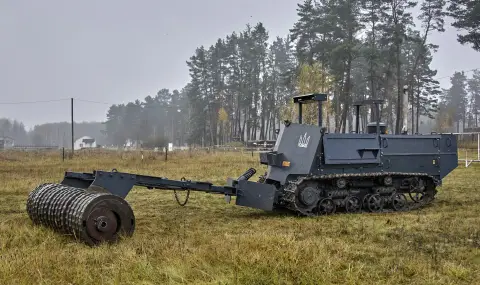Ukraine's mine problem is threatening the world's food supply. This indicates an international study by the Institute for Global Change "Tony Blair" in London. In front of the Ukrainian service of Radio Free Europe a Ukrainian farmer says he has to "take out mines with his bare hands", "risking his life". Even after Russia's withdrawal from parts of Ukraine, many farmers sow grain and oilseed crops in mined fields.
A total of 25% of the territory of Ukraine should be checked
These days, Switzerland and Ukraine organized a conference, the purpose of which is to help clear about five million hectares of Ukrainian land from mines – this is nearly 10% of the cultivated land. In addition, about 140,000 square kilometers need to be checked – or nearly 25 percent of the total territory of Ukraine - for contamination with anti-personnel mines, unexploded ammunition and other explosive substances.
Agriculture is extremely important for the economy of Ukraine. Before the start of Russian aggression, it accounted for almost 11 percent of gross domestic product (GDP). According to the "Tony Blair" Institute landmines reduce Ukraine's GDP by 10.27 billion euros per year - which equates to about 5.6% of GDP in 2021.
Harvest in minefields
Due to Ukraine's huge landmine problem, the country's food exports are unlikely to reach pre-war levels in the foreseeable future, even in regions where Russian troops have been forced to withdraw. Demining is also important to prevent further environmental damage, such as the leakage of toxic chemicals into soil and water or the release of harmful substances into the atmosphere in explosions.
Clearing mines and other heavy metals from the war is key to restoring Ukraine to a leading grain exporter. Between 2016 and 2021, more than 90% of Ukraine's total wheat exports went to countries in Asia and Africa. After the invasion in 2022, however, the war made almost a quarter of the country's territory unusable - an area the size of Belgium.
Implications for the whole world
Yet Ukraine continues to be an important producer of food for the world. According to data from the Ukrainian Association of Grain Producers, in 2023/2024 the country still exported 57.5 million tons of grain and oilseed crops, with the largest importers of Ukrainian wheat this season being Spain, Egypt and Indonesia.
The situation is now particularly difficult for some African countries. Egypt and the Democratic Republic of the Congo, for example, source more than 75% of their grain imports from Ukraine and Russia. Shortly after the war broke out, from February to March 2022, the food price index rose 12.6 percent, according to the United Nations' Food and Agriculture Organization. This is the highest monthly increase since the index was introduced in the 1990s.
Walter Leal, head of the Center for Research and Transfer at Hamburg University of Applied Sciences, says that countries such as Algeria and Libya have been able to cushion the effects of rising food prices with additional revenue from their oil exports and gas. For countries like Yemen, Lebanon and Sudan, however, "international food aid remains critical".
When will exports recover?
In 2023, Ukraine was again able to increase its grain exports thanks to an agreement with Russia that enabled exports from the port of Odessa. After that agreement expires in August 2023, Ukraine uses a new export corridor on the western coast of the Black Sea that runs through the territorial waters of Romania and Bulgaria. However, the threat of weaker Ukrainian exports remains significant.
Ukrainian economist Oleg Pendzin says landmines are just one of many problems facing the agricultural sector. "You can clear the mines and secure international funding, but even then drones will be able to attack and endanger workers," he says. The restoration of the "Nova Kakhovka" dam, which supplies water to Crimea, the Zaporizhzhya NPP and the entire region, is also crucial. In addition, the war led to a shortage of farm workers. “People have fled or been drafted into the army, so the land lies fallow. There is no one left to process it. Villages in eastern Ukraine are deserted, only the older residents remain, says Pendzin.
It is not yet clear when Ukraine will free itself from the legacy of the war. Interior Minister Ihor Klimenko said demining in Ukraine could take ten years. And his forecast is among the more optimistic.
Author: Anna Chaika
